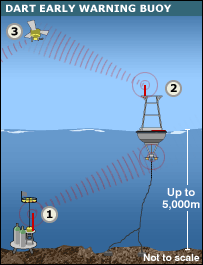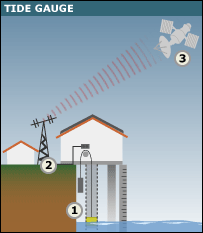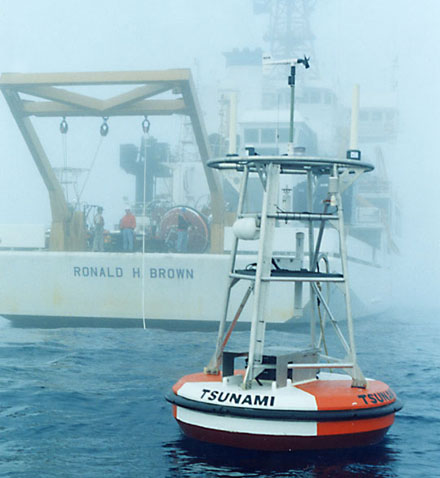Tsunami Warning Systems
An early warning system already exists in the Pacific Ocean and one is currently being installed in the Indian Ocean after the devastating Tsunami hit South East Asia in 2004.
There are different methods enabling to prediction:
Although seismic gauges can detect the earthquakes and volcanic eruptions that cause a tsunami, they are not suitable as the only form of tsunami warning system, as most earth vibrations don’t result in a warning.

1. Recorder on sea bed measures water pressure every 15 mins – an unusual result triggers a reading every 15 secs. 2. Buoy measures surface conditions and sends this plus data from sea bed to satellite. 3. Satellite receives data and relays it to ground stations
Two different kinds of sea-based instruments prove to be more effective:
DART Deep-ocean Assessment and Reporting of Tsunami
The DART receives data from a pressure recorder on the sea bed that measures the weight of the water above, recognizing increasing wave height, monitoring of surface conditions happens from a buoy on the sea surface. The measurements from the seabed are sent to the buoy, both sets of data are sent to a satellite which in turn, relays the data to ground stations. As the DART buoy detects tsunamis far out in the sea, it provides an early warning, giving countries enough time to prepare.
Germany is working on a joint project with Indonesia for installing such buoys.
GLOSS – Global Sea Level Observing System
A cheaper early warning method is offered by the GLOSS. Stations are sited on land, either on mainland coasts or islands. The surface of the water is either monitored by a system of tubes and floats, by radar or sonar, or by sea-bed pressure sensors attached to the station with a cable. Existing stations in the Indian ocean can be used for observing long-term climate change and with data transmitted periodically.

1. Float in a “stilling well” tube measures sea level. 2. Data is processed and sent to satellite. 3. Satellite transmits data to alert centres
By upgrading existing stations to send real-time data via satellite, they can be employed for Tsunami warning systems.
Countries also need to inaugurate a warning systems on land, which can bring the warnings to the people.
Source: news.bbc.co.uk




